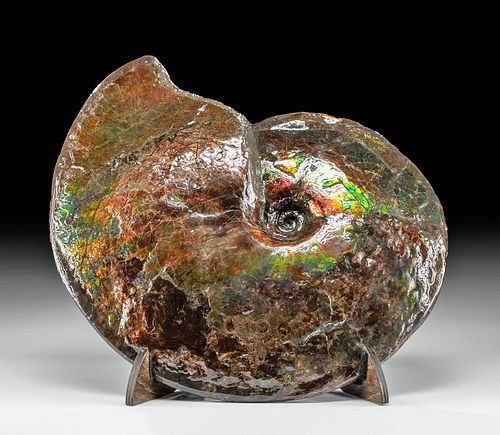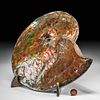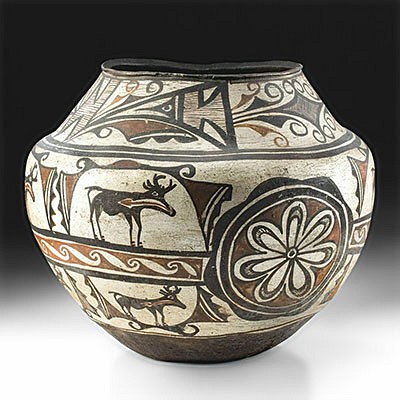Stunning Alberta Fossilized Ammolite Ammonite
Lot 106
About Seller
Artemis Fine Arts
686 S Taylor Ave, Ste 106
Louisville, CO 80027
United States
Selling antiquities, ancient and ethnographic art online since 1993, Artemis Gallery specializes in Classical Antiquities (Egyptian, Greek, Roman, Near Eastern), Asian, Pre-Columbian, African / Tribal / Oceanographic art. Our extensive inventory includes pottery, stone, metal, wood, glass and textil...Read more
Estimate:
$16,000 - $24,000
Absentee vs Live bid
Two ways to bid:
- Leave a max absentee bid and the platform will bid on your behalf up to your maximum bid during the live auction.
- Bid live during the auction and your bids will be submitted real-time to the auctioneer.
Bid Increments
| Price | Bid Increment |
|---|---|
| $0 | $25 |
| $300 | $50 |
| $1,000 | $100 |
| $2,000 | $250 |
| $5,000 | $500 |
| $10,000 | $1,000 |
| $20,000 | $2,500 |
| $50,000 | $5,000 |
| $100,000 | $10,000 |
| $200,000 | $20,000 |
About Auction
By Artemis Fine Arts
Nov 18, 2021
Set Reminder
2021-11-18 10:00:00
2021-11-18 10:00:00
America/New_York
Bidsquare
Bidsquare : Art & Artifacts of North America
https://www.bidsquare.com/auctions/artemis-gallery/art-artifacts-of-north-america-7894
Join us for a special auction not to be missed! Collectible Native American art from antiquity to mid-20th century, Spanish Colonial, Latin American, Pre-Columbian, fine & folk art, American frontier items, fossils, and much more! Artemis Fine Arts info@artemisgallery.com
Join us for a special auction not to be missed! Collectible Native American art from antiquity to mid-20th century, Spanish Colonial, Latin American, Pre-Columbian, fine & folk art, American frontier items, fossils, and much more! Artemis Fine Arts info@artemisgallery.com
- Lot Description
North America, Canada, Alberta, Bearpaw formation, late Cretaceous, ca. 71 million years ago. This is a breathtaking ammonite of the Placenticeras meeki genus with a large, iridescent ammolite shell. Ammolite is an organic gemstone that boasts an astonishing array of rainbows colors. Here, the brightness of this specimen's colors and the iridescence is a testament to the well-preserved state of the nacreous shell, and this fossil was prepared by the company Canada Fossils Ltd, the sister company to Korite, the largest commercial producer of natural ammolite gemstones and jewelry. Together, they provide ammonites and other amazing finds to important institutions, including an ammonite on display in the American Museum of Natural History in New York! This is a large shell, with a slightly recessed spiral, and a gorgeous specimen that needs to be seen in person under dazzling light to gain he full visual experience! Size: 11.5" Diameter x 1.75" W (29.2 cm x 4.4 cm); 7.5" H (19 cm) on included custom stand.
Plancenticeras meeki was anything but meek - this was a swift predator that swam after prey, and did not passively float in the current. Their genus name is in honor of Fielding Meek (1817 to 1876), a pioneer in American paleontology. They could reach a staggering 1 meter (3.3 feet) in diameter - imagine a shelled creature of that size with tentacles outstretched swimming by!
Ammolite is a rare, iridescent, gem-quality material cut from the fossilized shells of extinct sea creatures known as ammonites. Found only in the Bearpaw Formation in Alberta, Canada - along the eastern slopes of the Rocky Mountains - this organic gemstone has a dazzling range of colors and patterns and is highly desired for freeform natural cabochons and assembled jewelry pieces.
According to the International Gem Society (IGS) statement on the difference between Ammolite and Ammonite: "You may find the terms ammolite and ammonite sometimes used interchangeably. However, ammonite, strictly speaking, refers to the fossil shells of ammonites, whether gem-quality or not. Ammolite refers to the gem-quality material made from fossils of particular species of ammonites." Also according to IGS, "Ammonites were marine mollusks that became extinct around 65 million years ago. There were many species of ammonites, and their fossils have been found across the globe. The fossils of Placenticeras meeki, Placenticeras intercalare, and Baculites compressus can yield gem-quality ammolite. To date, this material has been found only in Alberta, Canada."
This piece has been searched against the Art Loss Register database and has been cleared. The Art Loss Register maintains the world's largest database of stolen art, collectibles, and antiques.
Provenance: private Berthoud, Colorado, USA collection
All items legal to buy/sell under U.S. Statute covering cultural patrimony Code 2600, CHAPTER 14, and are guaranteed to be as described or your money back.
A Certificate of Authenticity will accompany all winning bids.
PLEASE NOTE: Due to recent increases of shipments being seized by Australian & German customs (even for items with pre-UNESCO provenance), we will no longer ship most antiquities and ancient Chinese art to Australia & Germany. For categories of items that are acceptable to ship to Australia or Germany, please contact us directly or work with your local customs brokerage firm.
Display stands not described as included/custom in the item description are for photography purposes only and will not be included with the item upon shipping.
#167920Professionally prepared with a clear fixative on surface to protect the shell. Stable fissures from fossilization throughout. Gorgeous iridescence throughout.Condition
- Shipping Info
-
All shipping is handled in-house for your convenience. Your invoice from Artemis Gallery will include shipping calculation instructions. If in doubt, please inquire BEFORE bidding for estimated shipping costs for individual items.
-
- Buyer's Premium



 EUR
EUR CAD
CAD AUD
AUD GBP
GBP MXN
MXN HKD
HKD CNY
CNY MYR
MYR SEK
SEK SGD
SGD CHF
CHF THB
THB














